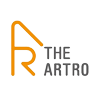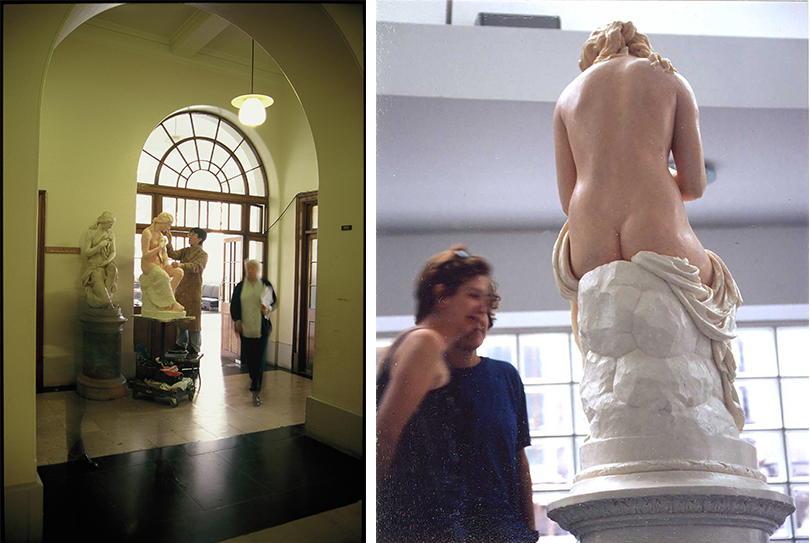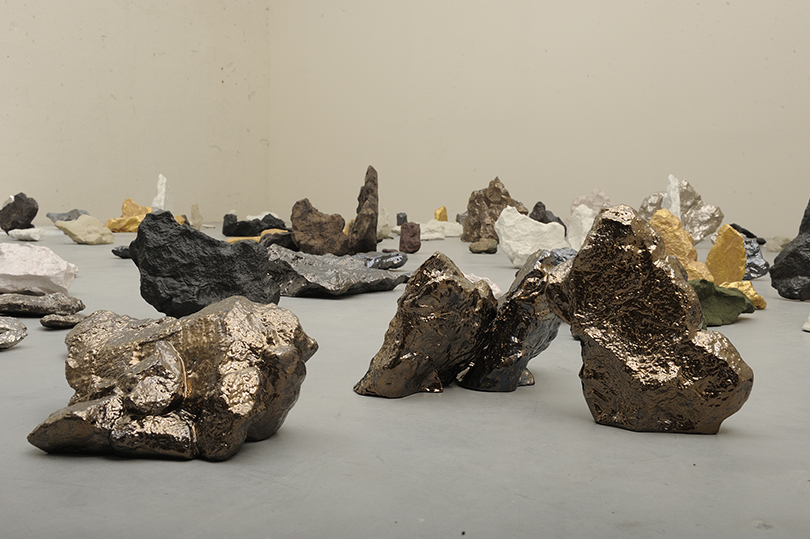
In September 2022, the Korea Arts Management Service (KAMS) collaborated with Art Asia Pacific, who specializes in Asian Art, to publish an in-depth look at Korean contemporary artists in the book Extreme Beauty: 12 Korean Artists Today including artworks from artists who each represent different genres, such as painting, installation, sculpture, video, etc. This gained particular interest, as it appeared during the busiest month in the Korean art market, with global attention focused squarely on Korea.
Each artist’s works are explored through critiques by both Korean and international experts. This composition transcends age and genre differences, and fully reflects the diversity and dynamism of contemporary Korean art.
The ARTRO will be featuring the “Behind the Beauty” series of articles to introduce the featured artists and their works, which will provide a better understanding of the book Extreme Beauty. In these feature articles, each artist will introduce a piece of their own work that he/she thinks is most meaningful and will tell the story behind it. Readers will be able to approach these pieces clearly and easily through such lively contextualisation.

Translation, installation view at the Haunch of Venison, London, in 2011. Ghost Series, Soap. Photo provided by the artist.
Meekyoung Shin's works seem to have been transported from museums in each country. Shin has continued to reproduce artifacts symbolizing each culture, such as Western classical statues, Asian pottery, and Buddhist statues. However, by being placed in a different location, her relics take on a subtly different meaning than the originals. Shin uses this to evoke the incompleteness of translation between cultures, caused by differences in space. The unique feature of these replicas is that they are all made of soap. Shin raises questions about the temporality and authority of relics made of solid materials, such as marble, by identically reproducing them with soft soap. She has been working with soap as her sole material for over twenty years. What do those 20 years of time mean to her, now so renowned as a ‘soap sculptor’? As a sculptor, what is her perspective of the future? This interview has been conducted to commemorate the publication of the book, Extreme Beauty: 12 Korean Artists Today, by the Korea Arts Management Service (KAMS) in collaboration with Art Asia Pacific. Following is an interview with artist Meekyoung Shin.
Can you describe the process of how you begin a new work?
It has been almost 30 years since I started my work as an artist, and during that time it became more difficult to separate the preparation process from the work itself. For me, everyday life other than work is all a preparation process. When I am not working, I try to gain knowledge and inspiration in my daily life by reading books or traveling somewhere. I also ruminate on what kind of work I will be making in the future. Although this use of time nourishes me, my work does not start from there immediately. As if a seed was planted in the soil, the things that grow out of my thoughts and experiences suddenly appear before me one day. This is the point when I begin my work.
Let me explain by using my work as an example. Before making the piece Ruinscape (2018), I went to see Hadrian's Wall1) in England. It was rather by chance that I went to see Hadrian’s Wall. It wasn’t a trip for making art or inspiration. I simply happened to take a trip across England along the wall with a reporter. As I walked along it, the remaining wall almost collapsed. The wall should have been a strong defensive fortification, however, after years and years, all we can see are traces of it. However, I thought that these traces are not something that has disappeared yet, but rather something that still exists, because we recall and imagine the original existence when we see the crumbling wall. I went back to my ordinary life again after the trip. Then, I was envisioning building a house using bricks made from soap. While I was struggling with various practical problems, my experience at Hadrian’s Wall suddenly came to mind. I thought that by depicting something ‘destroyed’ instead of something one is ‘building’ I could use traces to present the boundary between what exists and what disappears. That's how I came up with Ruinscape, which captures the traces of the ruins.

Ruinscape, 2018, soap. Photo provided by the artist.
You have been working as an artist for many years now. Can you introduce any work that you are personally attached to or that has a special meaning to you?
The most special piece would be my very first soap sculpture, Translation-Aphrodite (1998/restored in 2009). When I was studying at the Slade School, I modelled the classic antiquity Aphrodite in soap on campus over six months. The work was physically demanding but it turned out to be a meaningful beacon for my future works.
I would like to ask you what this work means to you.
Through my first piece of soap sculpture, I also tried to stride off. I wanted to tell so many stories through this work. One of the things that shocked me when I first came to England was that people don’t think much of the classic sculptures. When I was preparing for university in Korea, copying numerous Western classic sculptures was a standard task. At that time, Western classical pieces were not just a fine art canon but were also a contemporary thing for me. But in England those sculptures were just obsolete. Furthermore, when I was at the Slade School conceptual art was in full swing as well. These factors gave me many things to ponder, since I only studied to make specific figural sculptures. I agonised over what the sculptures I had been practicing so far were, and whether the sculptures were really outdated. Translation-Aphrodite contains all of these concerns. I wanted to deliver the irony of the situation by showing things located at the extreme ends of time and place: classics and contemporary, and the West and the East, all in one scene.
That's why I chose to work outside a studio. I consider the work Translation-Aphrodite to include performance. The act and meaning of the scene where I placed myself next to the statue of Aphrodite on campus and created a replica Aphrodite over the course of six months is also part of this work. These six months included the process of bringing the Aphrodite statue – which people consider to be old fashioned and ornamental – into a contemporary context. I tried to deliver the notion of temporality through the irony of making a solid marble statue with soft soap. It also looked quite strange to western eyes to see an Asian lady remaking a classic Western statue, since they had no idea that this is a classic canon of sculpture I had practiced numerous times for my university in Korea. This is also very ironic.

Translation-Aphrodite, 1998/restored in 2009, 82x62x226(h)cm, soap. Photo provided by the artist.

Translation-Aphrodite, 1998, 82x62x226(h)cm, soap. Photo provided by the artist.
Please tell us if there are any interesting anecdotes or stories behind your work during the process.
There were many anecdotes when I was working for Written in Soap: A Plinth Project (2012). This is a public art project where I created an equestrian statue on an empty plinth. I happened to come across the empty plinth when walking along the Cavendish Square in London. The original equestrian statue there was of the Duke of Cumberland. It was so interesting to find an empty plinth in the middle of the city. There was nothing physically on the plinth, but I discovered a mass of ‘time’. I thought it would be nice to make a mass of time, which both exists and does not exist, into soap. However, the research process was not easy. It took me four years from data research to completion of the work. I never imagined that there wouldn’t be that much materials left on the equestrian statue. This was quite the opposite of Translation- Aphrodite, since there was no original to follow. While researching, I found two drawings. One was a landscape that sketched a panoramic view of Cavendish Square, where the equestrian statue was included as one element of the landscape. The other was a satirical picture of an equestrian statue, so it was depicted ridiculously. Later, I found a small 20 inch model piece among the National Army Museum collections. I was able to trace a single form from comparing these three data sources. So I made the statue while inferring the original shape.
However, after the work was opened to the public, there was a heated debate over the Duke of Cumberland. He was a notorious man who conquered Scotland, and this re-creation of the statue triggered that traumatic history for the Scottish people. Although I was living in England, I grew up in Korea, and I didn’t know much about this historical context. A few years later, when Scotland voted on the independence referendum, people once again mentioned this equestrian statue, as it held great meaning to the people in Scotland. As I went through the series of incidents, I realized that relics acquire different meanings as time goes by, and that a people’s history, memories and emotions are engraved in these relics. Similarly, people remove symbols that celebrate slavery or cases of atrocity in war. This is one of the interesting parts of sculpture - that it does not remain merely an artwork but rather has larger implications.

Written in Soap: A Plinth Project, 2012, soap. Photo provided by the artist.

Translation Series, 2006-2013, soap, size variable. Photo provided by the artist.
A meme refers to an image, text, or video that is copied, reproduced and spread widely especially through social media. For young generations, making and spreading ‘meme’ is a kind of play and the process of copying, editing and reproduction has naturally become a daily routine. I wonder how you see such recent trend as an artist who has been working in the context of reproduction for a long time.
To be honest, I only came to know about 'memes' from this interview, but I found it very interesting. This series of phenomena has been re-established in short form as the word ‘meme’. Maybe my work, which I have been doing for over 20 years, can also be explained as a ‘meme’. It seems that one of the characteristics of a ‘meme’ is to copy and transform an image or text. During such a process, the original context is recontextualized. In this process of recontextualization, there will inevitably be some slippages and misunderstandings. I have been working on a project that raises questions about whether this can be called a misunderstanding, as in order to be able to define something as understanding or misunderstanding, it must have an original meaning. However, I don't think there is such a thing as the original meaning or unique value of the original. When I think about the actual meaning of the original 'meme', which can be interpreted in many ways, it may not have a clear answer, or it may not have had any set meaning from the beginning.
Among my works, Translation Series (2006-2013) deals with East Asian ceramics, which we consider to be the epitome of the potteries and ceramics. I reproduced the porcelain engraved with symbolic images of China and Chinoiserie in soap. However, the Chinese people do not consider the ceramic images in Translation Series to reflect their tradition. What we consider to be the epitome of Chinese ceramics were actually made for consumption in the West. Chinese ceramics become popular in Europe and were made in large quantities to appeal to European taste. In this way, a single scene, image or text takes on different meanings when placed in different temporal or spatial contexts. I have always acted as a filter between different time zones and various places throughout my work, including this Translation Series, and it's interesting to see that this aspect is connected to the characteristics of 'meme’.

Megalith Series, 2019, glazed stoneware. Photo provided by the artist.
Lastly, how does artistic practice affect your life as an artist?
It could be an absurd analogy, but there is an old Korean fairy tale about a man who gave a villain his arm when the villain demanded: ‘Give me an arm and I won’t eat you’. And then the villain said: ‘Give me a leg and I won’t eat you’, so he gave him his leg. In the end, only the trunk of his body remained, and he had to roll down the mountain. I am often reminded of this story, since work seems to me like giving away everything and then rolling down. (Laughter) I've been working for nearly 30 years now, so why couldn't there have been other options for me? But for me I think the most important thing remains to stay in the best condition possible for my work. I only wanted to do a better job, then and now. My biggest concern is being placed in a situation where I can’t work. Work is the biggest part of my life.
While continuing my artistic practice, I realised that my thoughts and movements remain in my work, and being able to leave and represent my life through my work is a great motivation for continuing that work. I wish I could continue my work like a marathon runner - I want to move forward steadily while thinking about an even better work. If such an effort of moving forward is worth something, I think there’s nothing more I could ask for.
To move forward, I am constantly trying new things. In 2015, I started my MA in Ceramics, which I completed in 2017. I wasn’t particularly interested in ceramics, but I wanted to explore a new material. I have created works across a wide spectrum using soap, but I was also starting to worry, and asked myself: 'maybe I am too tied to the medium of soap' or 'maybe I'm getting comfortable in this field, which I occupy, because no prior artist sculpted soap?' etc. If comparing my artistic practice to a marathon, not to try anything new would not be good for me. So, I am preparing to diversify into materials other than soap, and gradually begin to deal with mediums I have not encountered before. As a mid-career artist, I do have a fear of trying new things, but I am continuing to throw myself into my future work.
[Footnote]
1) It stretches for about 120 km from the east coast to the west coast of northern England. Roman Emperor Hadrian (reign 117-138) built it to drive out the Picts and secure the border. It served as both a defense and residential facility, and when the Roman army withdrew in 383, it was used as a defense against Scottish invasions until the early 17th century. Source: [Naver Encyclopedia] Hadrian's Wall (Doosan Encyclopedia, Doopedia).
Meekyoung Shin
Meekyoung Shin completed her BFA and MFA in Sculpture at the Seoul National University and obtained a second MFA at the Slade School of Art, University College London. Her use of soap sculpture in performance become the signature of her work. After graduation, Shin participated in the group exhibition “Addressing the Century: 100 Years of Art & Fashion” at the Hayward Gallery in 1998, where she presented her soap version of ancient classic sculptures from the British Museum’s collection. In 2004, she presented a soap sculpture performance at the Great Court of The British Museum in London. She also presented her work in many solo exhibitions internationally, including at the Arko Art Center, Space K Museum, MMCA, Seoul National University Museum, and Sungkok Art Museum in Korea, as well as Haunch of Venison, Belton House and Bristol Museum in the UK. Shin was nominated for the Korea Artist Prize in 2013, organized by MMCA, and was awarded the 2015 Singapore Prudential Eye Award in the sculpture category. She is now based in both London and Seoul.
www.meekyoungshin.com/


